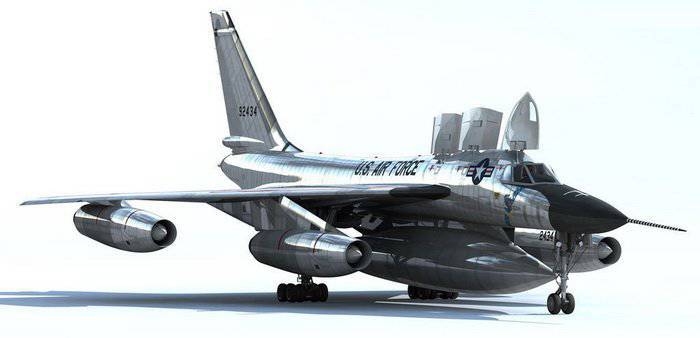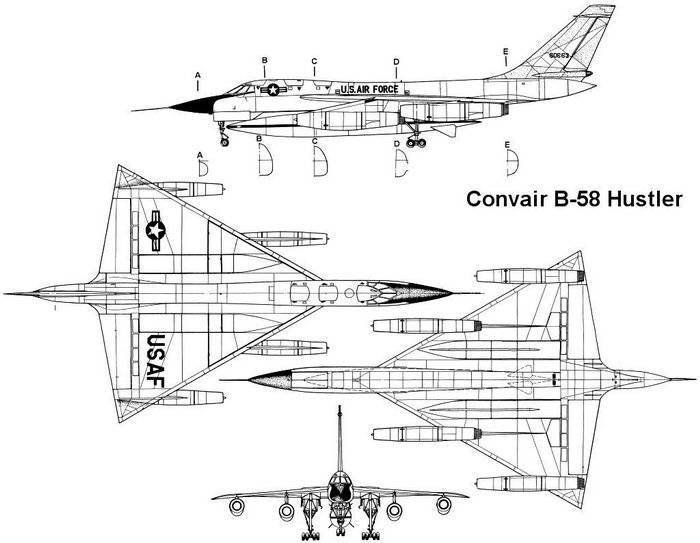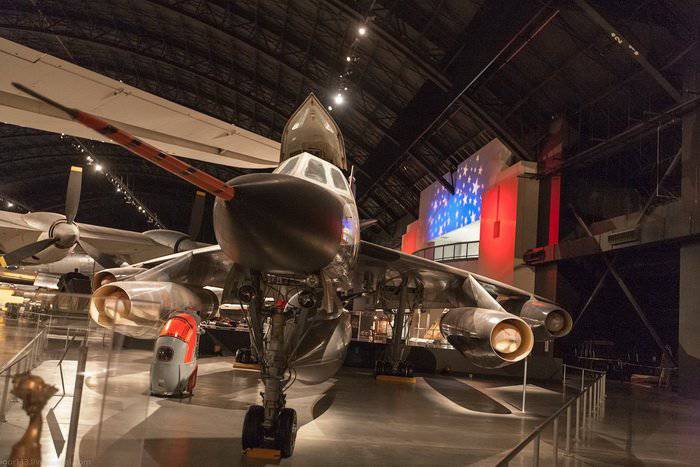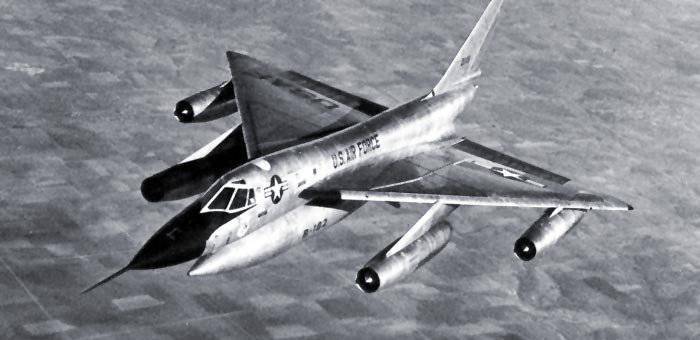The world's first supersonic bomber - B-58
In March 1949, the United States Air Force Aeronautical Research and Development Group (ARDC) issued requirements for the development of a supersonic long-range bomber. The design of the new machine was taken up by 2-e famous companies: Boeing and Convair, which are the main manufacturers of aircraft for the needs of the US Air Force. The task was quite difficult. Only by 1951, the companies managed to complete the refinement of their technical projects. 1 February 1952 of the year the customer sent the company a collection of updated TTH, presented to the new long-range supersonic bomber. Based on the requirements of the documentation, it was necessary to develop and build a bomber capable of flying in any weather conditions at low and high altitudes with a speed that would exceed the speed of sound. The range of the aircraft was determined at the level of 4 thousands of nautical miles, bomb load - 5 tons. In addition, the new bomber was supposed to be a multi-purpose machine. The creation of the first aircraft was given no more than 5 years.
Taking into account these wishes, the engineers of the two companies finalized their XB-58 and XB-59 projects and submitted them to the competition. Comparison of the two presented aircraft engaged in the Air Force Research Center. As a result of the comparison, the victory was gained by the aircraft produced by the company Konver. 10 December 1952, the aircraft received its official designation B-58, in the same year, Convair managed to get an order for the release of 18 data machines.

The B-58 bomber was designed in a tailless pattern and had a mid-winged delta wing with large sweep angles. The shape of the aircraft fuselage was chosen taking into account the area rule. About 15% of the surface of the aircraft was covered with a stainless steel shell, which very well prevented the heating of the bomber. Under the plane of each wing on one pylon was suspended 2 engine J57-P-15. However, this layout of the power plant did not last long. Soon it was found that because of the danger of overheating of the lower surface of the wing in the places of installation of internal engines, there is a real danger of fuel ignition in the wing tanks of the aircraft. Quite quickly, it was decided to install a turbofan on individual pylons. On the B-58 aircraft, rather unusual main landing gear was used, which had 4 pairs of wheels on each rack. The height of the landing gear was a few meters, which was due to the presence of a sufficiently large landing angle for the bomber, as well as the requirement to ensure free suspension of weapons, as the plane did not have its own bomb bay.
The crew of the long-range bomber B-58 consisted of 3-man - pilot, navigator-scorer, radio operator, operator of defensive systems. Initially, they were located in separate cabins equipped with ejection seats, but subsequently they were placed in a single sealed compartment. Each of the three workplaces had an individual opaque hatch, which was opened with the help of hydraulics. The operator and navigator compartments had 2 small rectangular windows in the sides, which were made so that the crew did not feel claustrophobic. However, according to the pilots themselves, there was simply no time for such nonsense, as well as for rest, during the flight: the equipment of the bomber required constant attention from the crew.
The B-58 was the first serial supersonic bomber in aviation history and therefore contained a large number of innovations. His creation was an attempt to reverse the trend established in those years, which led to an increase in the mass of aircraft to perform the required tasks. The relatively small size of the bomber made it sufficiently imperceptible - its EPR - effective dispersion surface (the most significant of the parameters when detecting the radar aircraft) ranged from 1 / 10 to 1 / 30 from the EPR of a B-52 bomber depending on the angle in space.

The design of the bomber differed great complexity and novelty. The hull and the wing were a single whole: the fuselage frames were smoothly transformed into the wing spars. During a long flight at a supersonic speed on the plane, in addition to the air velocity, there are acoustic and thermal loads. In order to ensure acceptable rigidity and structural strength, the wing was manufactured as much as an 33-spar. In this case, the step between the elements of this kind of "skeleton" was equal to the entire 280-330 mm. The front edge of the wing had a 60-degree sweep. She was well developed on previous aircraft company Convair.
In fact, the Hustler wing was a F-102 interceptor wing, which was proportionally increased. At the same time, due to the relatively small thickness of the wing profile, the mounting of the engine pylons, the layout of the power elements and the landing gear were a serious problem. Simultaneously, the wing of the bomber did not have takeoff and landing mechanization. To increase stability and to slightly improve its performance at high angles of attack, which were common to all tailless aircraft during landing, the front edge of the wing was made with a twist.
About 80% of the entire aircraft skin were glued laminated panels of 2-x duralumin sheets having a thickness from 0,25 to 1 mm., Which had a layer of cellular filler. In the places that were most exposed to heat, the “cells” were made of duralumin, and in the rest of the places - of fiberglass, which also had a high coefficient of thermal insulation. The panels were assembled using rubber-phenolic and epoxy-phenolic glue; very expensive new technologies were used to form them. Bomber B-58 Hustler had a very frequent and powerful power set, which was similar to the ship. The skin was attached to the “skeleton” of the aircraft using titanium and steel rivets, which provided the rigidity and smoothness of the external surfaces required for supersonic flights. It is worth noting that the large amount of work done by the designers gave its fruits, the Hustler glider turned out to be a record (even today) easy with a high level of rigidity.

B-58 bomber was almost always used with an external suspension under the fuselage. In this case, the aircraft could use: MC-1C - a guided missile equipped with an inertial guidance system and a fluid engine. The rocket could be equipped with either a warhead with a charge of conventional explosives or a nuclear warhead. The range of the launch of the MC-1C rocket directly depended on the flight altitude (should have been from 10 668 to 18 288 meters at the moment of UR separation from the aircraft) and ranged from 16 to 257 km. To launch such missiles, the crew had to raise a bomber to a great height, where it became a good target for enemy air defense systems. MB-1C - free-fall bomb or ballast to improve the flight characteristics of the aircraft. Usually used in the first years of operation B-58.
Also, the aircraft could use TCP - "two-component container." One of its parts was filled with fuel, and the other contained the Mk53 bomb. There were 2 variations of these containers: BLU2 / B1 and BLU2 / B2, which differed in size and weight. In addition, the aircraft could be the carrier of the megaton class 4-x Mk43 nuclear bombs. Hustler could also carry a container with reconnaissance equipment - MC-1. For the defense of the rear hemisphere of the aircraft on it in the rear fuselage was mounted 6 stolnaya 20 gun M61 Vulcan with remote control. In addition, the bomber was equipped with means of electronic countermeasures controlled arms the adversary. All the functions of managing defensive weapons systems were performed by a radio operator.
Due to the difficulty of operating the bomber, very high demands were placed on the pilots and on the ground staff. The combatant pilots were selected only on the personal recommendation of the commander of the wing and should have had at least 1000 hours of flight time on jet planes. In this case, half of the raid was to occur on flights as the commander of a multi-engine jet aircraft crew. In addition, due to the lack of free space in the cockpit, the pilots had to meet the requirements for weight and height. Ground staff to service the B-58 Hustler was also selected only from a number of very high-class specialists.

In total, the production time was made 116 aircraft B-58, which in combat units operated until the end of the year 1969. It is worth noting that the pilots did not particularly like these planes. During operation, for various reasons, 26 machines were lost (22,4% of all manufactured), which is a large enough indicator of peacetime losses. One of the bombers crashed in 1961 during a demonstration flight at the Paris Air Show. Despite the fact that in the course of its operation, work was constantly carried out on upgrading equipment and systems, the machine quickly became obsolete and, in the end, was removed from service with the US Air Force and deposited.
Flight performance B-58:
Dimensions: wingspan - 17,32 m., Length - 29,5 m., Height - 9,57 m.
Wing area - 143,3 square. m
Aircraft normal take-off weight - 68 000 kg., Maximum take-off - 80 235 kg.
The power plant - four General Electric J79-GE-5 TRDFs, unforced traction - 4x4536 kgf., Afterburner - 4X7076 kgf.
Maximum speed at altitude - 2126 km / h, on the ground - 980 km / h.
Practical range (without refueling) - 7160 km, with a full combat load - 5000 km.
Practical ceiling - 19 300 m.
Crew - 3 person.
Armament: one 20-mm six-barrel M61 Vulcan gun (1200 ammunition), Combat load - up to 7700 kg.
Information sources:
-http: //www.airwar.ru/enc/bomber/b58.html
-http: //www.airbase.ru/hangar/usa/convair/b/58
-http: //ru-aviation.livejournal.com/2503215.html
-http: //ru.wikipedia.org/wiki
Information